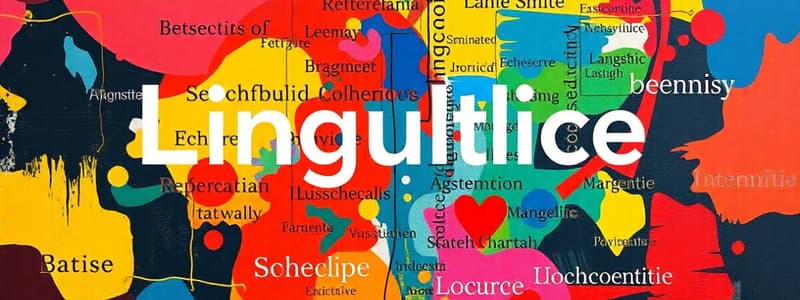Podcast
Questions and Answers
What does the term 'faculté de langage' refer to in the context of language?
What does the term 'faculté de langage' refer to in the context of language?
Which aspect of language refers to the individual event of using a code for communication?
Which aspect of language refers to the individual event of using a code for communication?
What is the working definition of a natural language outlined in the content?
What is the working definition of a natural language outlined in the content?
Which of the following is NOT considered a characteristic of languages based on the provided content?
Which of the following is NOT considered a characteristic of languages based on the provided content?
Signup and view all the answers
What role do social conventions play in the structure of languages?
What role do social conventions play in the structure of languages?
Signup and view all the answers
Which of the following best describes 'langue' as discussed in this content?
Which of the following best describes 'langue' as discussed in this content?
Signup and view all the answers
In discussing language, what does the term 'vocal signs' imply?
In discussing language, what does the term 'vocal signs' imply?
Signup and view all the answers
What does the variability of languages indicate about human communication?
What does the variability of languages indicate about human communication?
Signup and view all the answers
Which of the following concepts is NOT a subsystem of language, based on the provided content?
Which of the following concepts is NOT a subsystem of language, based on the provided content?
Signup and view all the answers
What is the primary function of the "pragmatics" subsystem, as described in the text?
What is the primary function of the "pragmatics" subsystem, as described in the text?
Signup and view all the answers
Which subsystem of language is specifically concerned with the structure of phrases and sentences?
Which subsystem of language is specifically concerned with the structure of phrases and sentences?
Signup and view all the answers
What is the primary focus of "variational linguistics", as explained in the provided information?
What is the primary focus of "variational linguistics", as explained in the provided information?
Signup and view all the answers
Based on the text, what is "lexicology" primarily concerned with?
Based on the text, what is "lexicology" primarily concerned with?
Signup and view all the answers
What does the text suggest about the relationship between "morphology" and "lexicology"?
What does the text suggest about the relationship between "morphology" and "lexicology"?
Signup and view all the answers
In the provided text, what is the meaning of the phrase "This lm has a lot of action"?
In the provided text, what is the meaning of the phrase "This lm has a lot of action"?
Signup and view all the answers
What is the primary characteristic of a symbol in semiotics?
What is the primary characteristic of a symbol in semiotics?
Signup and view all the answers
Which of the following examples is an index sign?
Which of the following examples is an index sign?
Signup and view all the answers
What is meant by the 'dual pattern' in natural languages?
What is meant by the 'dual pattern' in natural languages?
Signup and view all the answers
Which of the following best describes the concept of 'displacement' in language?
Which of the following best describes the concept of 'displacement' in language?
Signup and view all the answers
What does 'cultural transmission' in language refer to?
What does 'cultural transmission' in language refer to?
Signup and view all the answers
Which linguistic feature allows breaks in communication through distinct units?
Which linguistic feature allows breaks in communication through distinct units?
Signup and view all the answers
Charles Sanders Peirce associated which type of sign with similarity?
Charles Sanders Peirce associated which type of sign with similarity?
Signup and view all the answers
What is the nature of 'openness' in natural languages?
What is the nature of 'openness' in natural languages?
Signup and view all the answers
How does iconicity contribute to language understanding?
How does iconicity contribute to language understanding?
Signup and view all the answers
Which feature of language is indicated by the term 'arbitrariness'?
Which feature of language is indicated by the term 'arbitrariness'?
Signup and view all the answers
Flashcards
Language
Language
A unique human ability to articulate and understand.
Langue
Langue
The knowledge of a particular system of rules (a code) for communication.
Parole
Parole
The individual event of using a language code in communication.
Ferdinand de Saussure
Ferdinand de Saussure
Signup and view all the flashcards
Physical events in language
Physical events in language
Signup and view all the flashcards
Biological basis of language
Biological basis of language
Signup and view all the flashcards
Social conventions in language
Social conventions in language
Signup and view all the flashcards
Function of language
Function of language
Signup and view all the flashcards
Phonology
Phonology
Signup and view all the flashcards
Morphology
Morphology
Signup and view all the flashcards
Lexicology
Lexicology
Signup and view all the flashcards
Semantics
Semantics
Signup and view all the flashcards
Syntax
Syntax
Signup and view all the flashcards
Pragmatics
Pragmatics
Signup and view all the flashcards
Dialectology
Dialectology
Signup and view all the flashcards
Variational Linguistics
Variational Linguistics
Signup and view all the flashcards
Linguistic Sign
Linguistic Sign
Signup and view all the flashcards
Signifier
Signifier
Signup and view all the flashcards
Signified
Signified
Signup and view all the flashcards
Icon
Icon
Signup and view all the flashcards
Index
Index
Signup and view all the flashcards
Symbol
Symbol
Signup and view all the flashcards
Arbitrariness
Arbitrariness
Signup and view all the flashcards
Duality of Patterning
Duality of Patterning
Signup and view all the flashcards
Displacement
Displacement
Signup and view all the flashcards
Cultural Transmission
Cultural Transmission
Signup and view all the flashcards
Study Notes
Introduction to English Linguistics - Basic Notions
- Language is unique to humans, enabling articulation and understanding.
- Language encompasses knowledge of a system of rules (a code) used for communication.
- A language in use (parole) is the individual event of applying this code to communicate.
- Linguistics studies language's structure and properties.
Language and Linguistics - Definition of Language
- A language is a system of vocal signs agreed upon by a group for communication.
- Language uses physical events (sounds) to convey meaning.
- Language is shaped by biological factors and social conventions, and varies among individuals, groups, and regions.
Ferdinand de Saussure
- Language (langage) is defined as the general human ability to create and use language.
- Langue is the knowledge of a particular language's rules, a system of rules forming a language.
- Parole is a particular language in use, the individual act of communication.
Linguistic Sign
- Linguistic signs, like others, convey a concept or meaning.
- The signifiant is the sound or symbol.
- The signifié is the thought or concept associated with it.
- Examples include the word "mouse" and the concept or image of a mouse.
Types of Signs
- Icons: These convey meaning through visual resemblance; an image of a cloud to convey rain.
- Indexes: These signify meaning through cause and effect; smoke implies fire.
- Symbols: Meaning is arbitrary and learned; a national flag, or a traffic stop sign, convey meaning because of conventional agreement.
Linguistic Systems - Subsystems
- Phonology: the study of sounds in language.
- Morphology: the study of word forms.
- Lexicology: the study of words, vocabulary.
- Semantics: the study of meaning.
- Syntax: the study of sentence construction.
- Text Linguistics: the order of sentences and related language
- Pragmatics: language use for social interaction.
- Variational Linguistics: language variations based on history, social groups, regions, or style (e.g. dialects)
Design Features of Natural Language
- Arbitrariness: No inherent connection between sound and meaning.
- Discreteness: Language is made up of distinct units.
- Vocal - auditory channel: Language is made up of vocal sounds.
- Displacement: Language allows communication about events not in the present.
- Cultural Transmission: Language is learned from other humans, rather than inherited genetically.
- Openness: Language adapts and changes over time, creating new expressions and meanings.
- Duality of patterning: Language's units combine in meaningful ways to create infinite possibilities.
Studying That Suits You
Use AI to generate personalized quizzes and flashcards to suit your learning preferences.
Related Documents
Description
Explore the foundational concepts of English linguistics, including language as a unique human attribute and the system of rules that governs communication. Understand the differences between langue and parole as defined by Ferdinand de Saussure. This quiz will test your knowledge on the definitions and importance of language in society.




